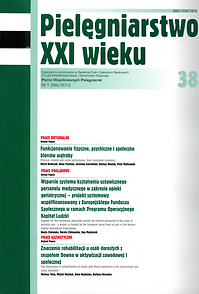Nietrzymanie moczu u kobiet a zaburzenia depresyjne
Słowa kluczowe:
nietrzymanie moczu, zaburzenia depresyjne, pielęgnowanie z NTMAbstrakt
NIETRZYMANIE MOCZU U KOBIET A ZABURZENIA DEPRESYJNE
Wprowadzenie. Nietrzymanie moczu jest schorzeniem niezwykle uciążliwym, które w przypadku nieleczenia, czy nieodpowiedniej pielęgnacji może prowadzić do powikłań wtórnych, zarówno somatycznych, jak i psychologicznych. Charakter choroby i czas trwania sprzyjają wystąpieniu zaburzeń depresyjnych.
Cel pracy. Ocena występowania zespołu depresyjnego u kobiet dotkniętych problemem inkontynencji.
Materiał i metody. w badaniach wzięło udział 100 kobiet z inkontynencją. Badania przeprowadzono w Oddziale Ginekologicznym Szpitala im. Józefa Dietla w Krynicy-Zdroju. Zastosowano metodę sondażu diagnostycznego oraz metodę szacowania. Narzędziami badawczymi były kwestionariusz ankiety własnej konstrukcji oraz wystandaryzowana Skala Depresji Becka.
Wyniki badań. Najczęstszym rodzajem NTM było wysiłkowe nietrzymanie moczu. Zaburzenia depresyjne zaobserwowano u 64% ankietowanych. Kobiety z nietrzymaniem moczu miały najczęściej łagodną lub umiarkowaną depresję (63%). Emocje, które dominowały u kobiet z NTM to wstyd (39%), złość (20%), przygnębienie (15%).
Wnioski. Częstość występowania zaburzeń depresyjnych u kobiet z NTM wzrasta wraz z wiekiem i czasem trwania choroby. Pomoc psychologiczna w związku z problemem NTM nie jest oferowana. Wsparcia ze strony psychologa oczekuje 41% badanych. Pracownicy medyczni powinni udzielać kobietom z NTM głównie wsparcia informacyjnego i instrumentalnego.
Bibliografia
1. Bidzan M. Medyczne aspekty nietrzymania moczu. [w:] Jakość życia pacjentek z różnym stopniem nasilenia wysiłkowego nietrzymania moczu. Kraków: Oficyna Wydawnicza Impuls; 2008, s. 25-28.
2. Radziszewski P, Dobroński P. Nietrzymanie moczu. Warszawa: PZWL; 2008,
s. 16-27.
3. Marianowski L. Diagnostyka i leczenie nietrzymania moczu u kobiet. Kwartalnik NTM. 2003; 4: 4-7.
4. Zielińska A, Smolarek N, Pisarska-Krawczyk M. Nietrzymanie moczu u młodych kobiet. Gin. Prakt. 2009; 2: 19-23.
5. Pisarska M, Mojs E, Sajdak S. Problemy psychologiczne i społeczne chorych z nietrzymaniem moczu. [w:] Opala T, red. Ginekologia. Warszawa: PZWL; 2003, s. 210.
6. Pilarska B. Rola pielęgniarki urologicznej w opiece nad pacjentkami z NTM. Choroba z „rumieńcem”. Kwartalnik NTM. 2009; 4 (31): 12.
7. Bidzan M. Psychologiczne aspekty nietrzymania moczu. [w:] Jakość życia pacjentek z różnym stopniem nasilenia wysiłkowego nietrzymania moczu. Kraków: Oficyna Wydawnicza Impuls; 2008, s. 33-49.
8. Tołłoczko T. Chorobliwe poczucie niechcianego wstydu. Kwartalnik NTM. 2007; 1 (20): 13-14.
9. Beck AT, Ward CH, Mendelson M et al. An inventory for measuring depression, Archives of General Psychiatry. 1961; 4: 53-63. [Data cytowania 07.06.2011]. Dostępny pod adresem: http://psychoterapiagdynia.eu/Beck.pdf.
10. Rechberger T, Jakowicki JA. red. Nietrzymanie moczu u kobiet. Wyd. II poszerzone. Lublin: Bifolium; 2005, s. 21-24.
11. Orlińska-Broda J, Radziszewski P, Borkowski A. Ocena depresji i lęku u kobiet z nietrzymaniem moczu. [Data cytowania 17.06.2011]. Dostępny pod adresem: http://www.urologiapolska.pl/numer.php?120
12. Michalska-Leśniewicz M, Gruszczyński W. Jakość życia kobiet z zaburzeniami depresyjnymi. Psychiatria. 2010; 2 (7): 53-60.
13. Kowalewska M. „O związkach pomiędzy NTM a psychiką…”. Kwartalnik NTM. 2010; 4 (35): 4-6.
Pobrania
Opublikowane
Numer
Dział
Licencja
Prawa autorskie (c) 2012 Beata Ogórek-Tęcza, Aneta Pulit (Autor)

Utwór dostępny jest na licencji Creative Commons Uznanie autorstwa 4.0 Międzynarodowe.




